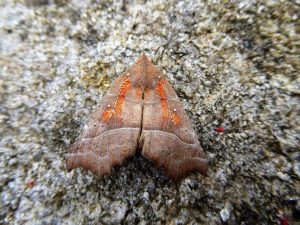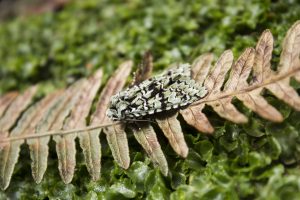October is, in fact, not renowned for butterflies or moths.
Mild October weather will see some Red Admirals, Small Tortoiseshells, Commas, Speckled Woods, and the very occasional Peacock visiting gardens for over-ripe fruit and hedges for over-ripe berries and late nectar. Painted Lady butterflies can sometimes be found, usually at the coast. Occasional Small Whites and Large Whites will hatch in October instead of over-wintering in their pupae, proving eye-catching at this time of year. In some years a small number of Holly Blue butterflies will show up in warmer parts of the country, such as in Dublin, near the coast, and will be found on Common Ivy, its main food plant at this time of year. You might even stumble on a late Small Copper on a patch of patchily vegetated peat or eroding sand dune, absorbing the thinning autumn sunshine.
Of these, the most reliable butterflies at this time of year are Red Admirals and Small Tortoiseshells, usually flying quite high or basking on a south facing wall.
But all of these butterflies really belong to spring and summer. Autumn is their twilight home, very much an abode of last resort. Now they are no longer wide-ranging and carefree, restricted by diminished nectar and declining temperatures. Autumn is neither their era nor friend. While many of us enjoy the rich colour autumn brings to the landscape, this will be ripped down by November storms. You will wake to see summer’s leafy temple torn down; gone are the golds, russets, rich reds and purples; left are the gnarled bony boughs. And the butterflies are gone too.
Autumn can deceive the nature-lover, and nature. Some plants will produce a second set of flowers. And sow thistles, those tall, plants with showy golden flowers continue to shine, while late Devil’s-bit Scabious blossom, now looking darker blue, lend the illusion of a continuing bounty. The ivy flowers continue to ooze fat globules of sweetness and are heavily frequented by bees and wasps. Struck by this illusion of unending summer, the poet John Keats in his masterpiece “To Autumn” describes how autumn conspires with the sun to
“set budding more, /And still more later flowers for the bees/Until they think warm days will never cease / For Summer has o’er-brimm’d their clammy cells”.
The richly sensuous nature of this imagery, the appeal to sight (budding, flowers, bees) and the tactile sense (warm, clammy) create a rich, reassuring vista in which the seasonal shift is bare perceptible.
Yet winter is on its way, and Keats knew it. He closes his poem with references to the advancing season:
“And the red-breast whistles from a garden-croft/And gathering swallows twitter in the skies”.
Butterflies too must prepare for the cold months. In autumn most Red Admiral and most likely all Painted Lady butterflies move south across the seas, chasing the sun and resources fast fading here. The Peacock and Small Tortoiseshell will stay put, hiding from the cold in cool, dry recesses. These two play the long game, delaying breeding until better days come in the following year. The Large and Small Whites, Speckled Woods, Holly Blues and Small Coppers that emerged late, deceived by the autumn sun perish in the wind and rain but some get the chance to leave eggs behind. These must hatch and develop swiftly to have any chance of adulthood.
But most of our butterflies exist over winter in the least demanding, low-maintenance forms. Some are tucked up in their pupae, others stay in the egg stage while the rest are either small caterpillars or caterpillars that have finished feeding. These survival strategies get them through the lean months, especially November, December, January and February. In years with cold springs, winter survival strategies are maintained until conditions improve. Our butterflies are resilient, well-adapted to our seasons. All they need is good homes.
Unlike our butterflies, there are moths that specialise in flying during October. For some moths, October is their time. Some are beautiful, but rarely seen. The Herald, named for the heraldic appearance, prepare to over-winter as an adult by feeding on ivy flowers and extra-ripe blackberries. The Herald is a well-built long-lived species, which can be found from September to June. This lovely insect will spend the hostile months in your attic, sometimes in large groups. Another autumn beauty is the Merveille du Jour, the freshly hatched moth green and flecked with black. Unlike The Herald, this creature breeds in autumn, leaving its eggs to spend the winter on oak twigs. For its distinctive moths, October has its benefits!




